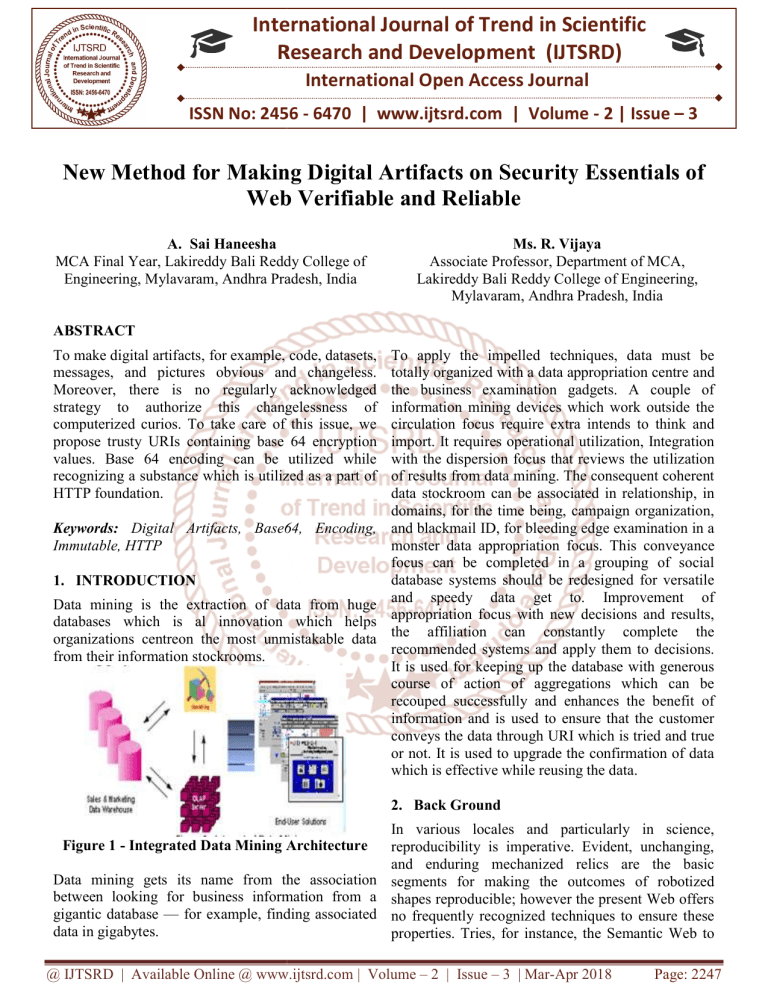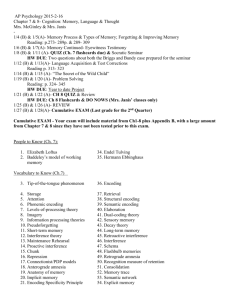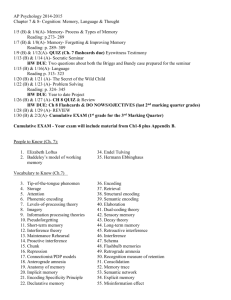
International Journal of Trend in Scientific
Research and Development (IJTSRD)
International Open Access Journal
ISSN No: 2456 - 6470 | www.ijtsrd.com | Volume - 2 | Issue – 3
New Method for Making Digital Artifacts
facts on Security Essentials of
Web Verifiable and Reliable
A. Sai Haneesha
MCA Final Year, Lakireddy Bali Reddy College oof
Engineering, Mylavaram,, Andhra Pradesh, India
Ms. R. Vijaya
Associate Professor,, Department
Dep
of MCA,
Lakireddy Bali Reddy College of
o Engineering,
Mylavaram, Andhra Pradesh, India
ABSTRACT
To make digital artifacts, for example, code, datasets,
messages, and pictures obvious and changeless.
Moreover, there is no regularly acknowledged
strategy to authorize this changelessness of
computerized curios. To take care of this issue, we
propose trusty URIs containing
ning base 64 encryption
values. Base 64 encoding can be utilized while
recognizing a substance which is utilized as a part of
HTTP foundation.
Keywords: Digital Artifacts, Base64, Encoding,
Immutable, HTTP
1. INTRODUCTION
Data mining is the extraction of data from huge
databases which is al innovation which helps
organizations centreon the most unmistakable data
from their information stockrooms.
To apply the impelled techniques, data must be
totally organized with a data appropriation centre and
the business examination gadgets. A couple of
information mining devices which work outside the
circulation focus require extra intends to think and
import. It requires operational utilization, Integration
with the dispersion focus that reviews the utilization
uti
of results from data mining. The consequent coherent
data stockroom can be associated in relationship, in
domains, for the time being, campaign organization,
and blackmail ID, for bleeding edge examination in a
monster data appropriation focus. This
Th conveyance
focus can be completed in a grouping of social
database systems should be redesigned for versatile
and speedy data get to. Improvement of
appropriation focus with new decisions and results,
the affiliation can constantly complete the
recommended
ded systems and apply them to decisions.
It is used for keeping up the database with generous
course of action of aggregations which can be
recouped successfully and enhances the benefit of
information and is used to ensure that the customer
conveys the data
ta through URI which is tried and true
or not. It is used to upgrade the confirmation of data
which is effective while reusing the data.
2. Back Ground
In various locales and particularly in science,
reproducibility is imperative. Evident, unchanging,
and enduring mechanized relics are the basic
Data mining gets its name from
rom the association segments for making the outcomes of robotized
between looking for business information from a shapes reproducible; however the present Web offers
gigantic database — for example, finding associated no frequently recognized techniques to ensure these
data in gigabytes.
properties. Tries, for instance, the Semantic Web to
Figure 1 - Integrated Data Mining Architecture
@ IJTSRD | Available Online @ www.ijtsrd.com | Volume – 2 | Issue – 3 | Mar-Apr
Apr 2018
Page: 2247
International Journal of Trend in Scientific Research and Development (IJTSRD) ISSN: 2456-6470
appropriate complex learning in a machine- changed yet rather to be copied and to watch that it is
interpretable manner maddens this issue, as trusted data posted by the affirmed person.
motorized calculations chipping away at tremendous
measures of data can be required to be impressively 5. Module Description
more exposed than individuals to control or spoiled
substance.
Without
fitting
countermeasures,
dangerous entertainers can destruct or trap such
calculations by adding just absolutely controlled
things to broad game plans of data
3. PROPOSED SYSTEM
This approach fuses cryptographic hash regards in
the Web URI's, especially affirmation and
decentralized outline. Our proposed approach comes
down to references can be kept an eye if, despite
everything that it contains a hash estimation of the
referenced Digital trinket. This method does not have
any critical bearing for each URIs, clearly, yet rather
just to those which is to exhibit and changeless
electronic collectible. We also propose trusty URI's
for the web knick-knacks to be trustworthy and more
secure.
Algorithm: Base64 encoding is used to perceive the
information in a HTTP area. For instance, a database
constancy framework may use Base64 encoding to
encode a by and large broad fascinating id into a
string for use as a HTTP parameter in HTTP
structures or HTTP GET URLs. In like manner,
various applications need to encode parallel data in a
way that is favourable to be consolidated into URLs
or covered web shape fields, and Base64 is a useful
encoding to render them in a limited way.The
calculation which is used as a piece of this module is
changes over the ASCII motivating force to base64
String which offers security to the data that will be
sent as a strong data. This keeps from unapproved
interpreting of data.
4. Significance of the Project
The wander focuses in giving the substance of the
data certain invariable and ceaseless with the
objective that it can be used as a piece of various
locales particularly in science since reproducibility is
indispensable for making the outcomes of automated
process. It makes the substance of the data tried and
true which is sent as a URI to the customer and it
guarantee whether it is trusted or not. It can be used
generally in investigate centres where analysts
disseminate research papers the papers are not to be
Figure 2 – Architecture
Authentication and Authorization: Authentication
is a technique in which the accreditations gave is
checked to those on record in a database of endorsed
customers' information in an area database or inside a
confirmation server. Endorsement is the limit of
demonstrating access to resources related to
information security and PC security when all is said
in done and to get the opportunity to control. In this
endeavour affirmation is done to give more
prominent security to the customers to have their
own confirmations to sign in. The chairman supports
the customers who are enrolled and offer rights to
login to the method.
Cache of the Data: Cache which is for the most part
used and incredibly unfaltering yet has not changed
in years and is never again successfully made. The
Cache is planned to help an architect in hanging on
data for a foreordained time span. In this wander, it is
used as the social affair of data to store which is used
for various taking care of.
Secured Distribution (Encoding and Decoding):
Encoding is the path toward making a progression of
characters, for instance, letters, numbers, highlight,
and certain pictures et cetera into a particular game
plan for gainful transmission or limit. Deciphering is
the contrary method - the difference in an encoded
plan indeed into the main progression of characters.
In Encoding, the data which are to be appropriated is
being encoded and it is being changed into encoded
regards and set away it in the database. In Decoding,
@ IJTSRD | Available Online @ www.ijtsrd.com | Volume – 2 | Issue – 3 | Mar-Apr 2018
Page: 2248
International Journal of Trend in Scientific Research and Development (IJTSRD) ISSN: 2456-6470
the changed over data is being decoded back just if Level 3:
the honest to goodness customer enters else, it
exhibits that you can't get to the record.
Distributing the data: Data disseminating is the
route toward making the data open on the Internet,
with the objective that they can be gotten to,
separated and reused by anyone for investigate or
distinctive purposes. The data is being circulated
where the appropriate level has the agree to get to the
archive which is controlled by the head.
6. Data Flow
Level1: Login:
Figure 5-User
7. CONCLUSION
Figure 3-Login
Level 2: Admin:
We have given a suggestion for express URI
references to make modernized relics on the
(Semantic) Web to be sure, invariable and enduring.
In case got, it could impressively influence the
structure and working of the Web, could enhance the
profitability and exactness of gadgets using Web
resources, which transforms into a basic specific
section for the Semantic Web, especially for
intelligent data, where provenance and sureness are
vital. Further; we have started to develop a
decentralized nanopublication server mastermind.
Nanopublications are passed on and rehashed among
such servers and recognized by trusty URIs,
therefore ensuring that these antiquated rarities stay
accessible paying little mind to whether solitary
servers are finished. Additionally, we are tackling the
possibility of nanopublication records that think
about the definition and ID of little or enormous
game plans of nanopublications.
REFERENCES
Figure 4-Admin
1. J. Carroll, “Signing RDF graphs,” in Proc. 2nd.
Semantic Web Conf., The Semantic Web, 2003,
pp. 369–384.
2. E. H€ofig and I. Schieferdecker, “Hashing of
RDF graphs and solution to the blank node
problem,” Proc. 10th Int. Workshop Uncertainty
Reasoning Semantic Web, 2014, pp. 55.
3. M. Bellare, O. Goldreich, and S. Goldwasser,
“Incremental cryptography: The hashing and
signing,” in Proc. 14th Annu. Int. Cryptol. Conf.,
Adv. Cryptol., 1994, pp. 216–233.
@ IJTSRD | Available Online @ www.ijtsrd.com | Volume – 2 | Issue – 3 | Mar-Apr 2018
Page: 2249
International Journal of Trend in Scientific Research and Development (IJTSRD) ISSN: 2456-6470
4. M. Bellare, O. Goldreich, and S. Goldwasser,
“Incremental cryptography: The hashing and
signing,” in Advances inCryptology —
CRYPTO’94. Springer, 1994, pp. 216–233.
5. C. Sayers and A. Karp, “Computing the digest of
RDF graph,”Mobile and Media Systems
Laboratory, HP Laboratories, PaloAlto, USA,
Tech. Rep. HPL-2003-235(R.1), 2004.
6. R. Phan and D. Wagner, “Security considerations
for incremental hash functions pair block
chaining,” Computers &Security, vol. 25, no. 2,
pp. 131–13, 2006.
7. C. Sayers and A. Karp, “Computing the digest of
an RDF graph,” Mobile and Media Systems
Laboratory, HP Laboratories, Palo Alto, USA,
Tech. Rep. HPL-2003-235(R.1), 2004.
8. R. Phan D. Wagner, “Security considerations for
incremental hash functions based pair block
chaining,” Compute. Security, vol. 25, no. 2, pp.
131–136, 2006.
9. T. Kuhn and M. Dumontier, “Trusty URIs:
Verifiable, immutable, permanent digital
artifacts for linked data,” in Proc. 11th Extended
Semantic Web Conf., 2014, pp. 395–410.
10. P. Growth, A. Gibson, J. Velterop, “The
anatomy of a nanopublication,” Inf. Serv. Use,
vol. 30, no. 1, pp. 51–56, 2010.
11. Farrell, Kutscher, C.Dannewitz, B.Ohlman,
A.Keranen, Hallam-Baker, “Naming things with
hashes,”
Internet
Engineering
Taskforce(IETF),StandardsTrackRFC6920,Apr.2
01 3.
12. R. Gentleman, “Reproducible research: A
bioinformatics study,” Statistical applications in
genetics and molecular biology,vol. 4, no. 1,
2005.
13. F. Belleau, M. Nolin, N. Tourigny, P. Rigault, J.
Morissette,“Bio2RDF: towards a mashup to build
bioinformatics knowledgesystems,” Journal
Biomedical Informatics, vol. 41, no. 5, pp. 706–
716, 2008.
14. A. Callahan, J. Cruz-Toledo, and M. Dumontier,
“Ontology-based querying Bio2RDF’s linked
data,” Journal of BiomedicalSemantics, vol. 4,
no. Suppl 1, p. S1, 2013.
15. T. Kuhn, C. Chichester, M. Dumontier, M.
Krauthammer,“Publishing without publishers: a
decentralized approach todissemination, retrieval,
and
archiving
of
data,”
arXiv
preprintarXiv:1411.2749, 2014.
16. H. Van de Sompel, R. Sanderson, H. Shankar,
and M. Klein,“Persistent identifiers scholarly
assets and the web: The needfor an unambiguous
mapping,”
International
Journal
of
DigitalCuration, vol. 9, no. 1, pp. 331–342, 2014.
17. R.
D.
Peng,
“Reproducible
research
computational science,”Science, vol. 334, no.
6060, p. 1226, 2011.
18. O. S. Collaboration et al., “An open, large-scale,
collaborativeeffort estimate the reproducibilit
psychological
science,”Perspectives
on
Psychological Science, vol. 7, no. 6, pp. 657–
660, 2012.
About Authors:
Ms.A.SAI HANEESHA
is
currently pursuing her MCA in
LAKIREDDY BALIREDDY
COLLEGE
OF
ENGINEERING, Mylavaram,
A.P.
Ms.R.VIJAYA
is currently
working as an Associate
Professor in MCA Department,
LAKIREDDY BALIREDDY
COLLEGE
OF
ENGINEERING, Mylavaram.
@ IJTSRD | Available Online @ www.ijtsrd.com | Volume – 2 | Issue – 3 | Mar-Apr 2018
Page: 2250




